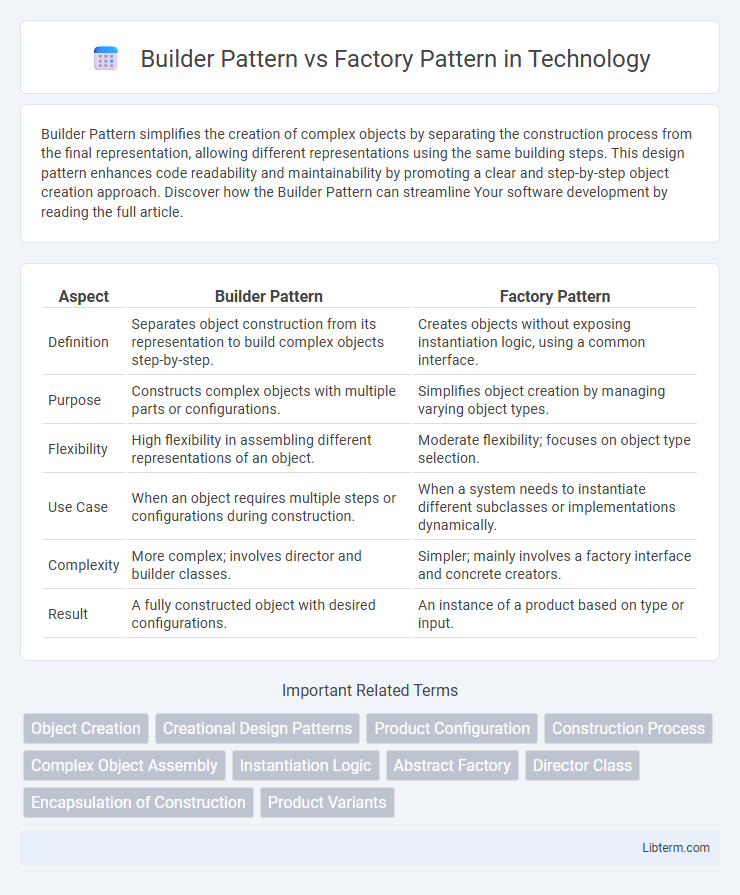Builder Pattern simplifies the creation of complex objects by separating the construction process from the final representation, allowing different representations using the same building steps. This design pattern enhances code readability and maintainability by promoting a clear and step-by-step object creation approach. Discover how the Builder Pattern can streamline Your software development by reading the full article.
Table of Comparison
| Aspect | Builder Pattern | Factory Pattern |
|---|---|---|
| Definition | Separates object construction from its representation to build complex objects step-by-step. | Creates objects without exposing instantiation logic, using a common interface. |
| Purpose | Constructs complex objects with multiple parts or configurations. | Simplifies object creation by managing varying object types. |
| Flexibility | High flexibility in assembling different representations of an object. | Moderate flexibility; focuses on object type selection. |
| Use Case | When an object requires multiple steps or configurations during construction. | When a system needs to instantiate different subclasses or implementations dynamically. |
| Complexity | More complex; involves director and builder classes. | Simpler; mainly involves a factory interface and concrete creators. |
| Result | A fully constructed object with desired configurations. | An instance of a product based on type or input. |
Introduction to Design Patterns
Design patterns provide reusable solutions to common software design problems, with Builder and Factory patterns addressing object creation but differing in scope and structure. The Builder pattern constructs complex objects step-by-step, offering fine-grained control over the creation process, ideal for scenarios where an object requires multiple configurations. The Factory pattern, either simple or abstract, focuses on creating objects without specifying the exact class, promoting flexibility and encapsulation in object instantiation across varying subclasses.
Overview of Builder Pattern
The Builder Pattern separates the construction of a complex object from its representation, enabling step-by-step creation with varied configurations. It encapsulates the process of assembling parts, promoting clarity and flexibility without directly exposing the object's representation. This pattern is ideal for producing different versions of a product while maintaining control over construction.
Overview of Factory Pattern
The Factory Pattern centralizes object creation by defining an interface for creating objects, allowing subclasses to alter the type of objects instantiated. This design pattern promotes loose coupling by delegating instantiation logic to factory classes, enhancing code maintainability and scalability. Commonly used in scenarios requiring dynamic object creation based on input or configuration, the Factory Pattern supports polymorphism and adherence to the Open/Closed Principle.
Key Differences Between Builder and Factory Pattern
The Builder Pattern separates the construction of a complex object from its representation, enabling step-by-step object creation with greater control over the process. In contrast, the Factory Pattern focuses on creating objects through a single interface or method, promoting object instantiation without exposing the creation logic. Key differences include Builder's emphasis on incremental building and configuration versus Factory's role in delegating instantiation to subclasses or methods based on input parameters.
Use Cases for Builder Pattern
The Builder Pattern excels in scenarios where complex objects require step-by-step construction, especially when creating different representations of the same object, such as building customizable user interfaces or complex document generation. It is particularly useful when an object's construction process involves assembling multiple components or product variations, like in meal preparation systems or vehicle assembly lines. This pattern improves code readability and maintainability by separating the construction logic from the final product, allowing flexible and controlled object creation.
Use Cases for Factory Pattern
The Factory Pattern excels in scenarios requiring the creation of objects without specifying the exact class, making it ideal for managing the instantiation process in frameworks or libraries. It is frequently used when a system needs to decide at runtime which subclass to instantiate based on input parameters or configuration details. Common use cases include creating database connections, GUI components, and logging objects, where the client code remains decoupled from the concrete implementations.
Advantages of Builder Pattern
Builder Pattern offers precise control over the construction process of complex objects by separating the object creation from its representation, enabling step-by-step customization. It enhances code readability and maintainability by managing intricate configurations without the need for multiple constructors or extensive parameter lists. This pattern improves flexibility in object creation, especially when constructing diverse product variations with numerous optional parameters.
Advantages of Factory Pattern
The Factory Pattern simplifies object creation by encapsulating the instantiation process, allowing for greater flexibility and scalability in complex systems. It promotes loose coupling between client code and concrete classes, making it easier to introduce new product variants without modifying existing code. This pattern enhances maintainability and supports a clean, centralized mechanism for object management, improving overall code organization.
When to Use Builder vs Factory Pattern
Builder Pattern is ideal for constructing complex objects step-by-step when the creation process involves multiple variations or configurations, allowing fine control over the object's construction sequence. Factory Pattern suits scenarios requiring object creation without specifying the exact class, promoting loose coupling by encapsulating instantiation logic behind a common interface. Use Builder when managing complex, multi-stage object creation, and Factory when the goal is to abstract and centralize simple object instantiation across different subclasses.
Conclusion and Best Practices
The Builder Pattern excels in constructing complex objects step-by-step with immutable and customizable configurations, while the Factory Pattern is ideal for creating objects without exposing instantiation logic, promoting loose coupling. Best practices recommend using the Builder Pattern when an object requires numerous optional parameters or varies significantly during creation, whereas the Factory Pattern suits scenarios needing polymorphic object creation encapsulated in a single interface. Combining both patterns can enhance code maintainability and flexibility, especially in large-scale software design.
Builder Pattern Infographic

 libterm.com
libterm.com